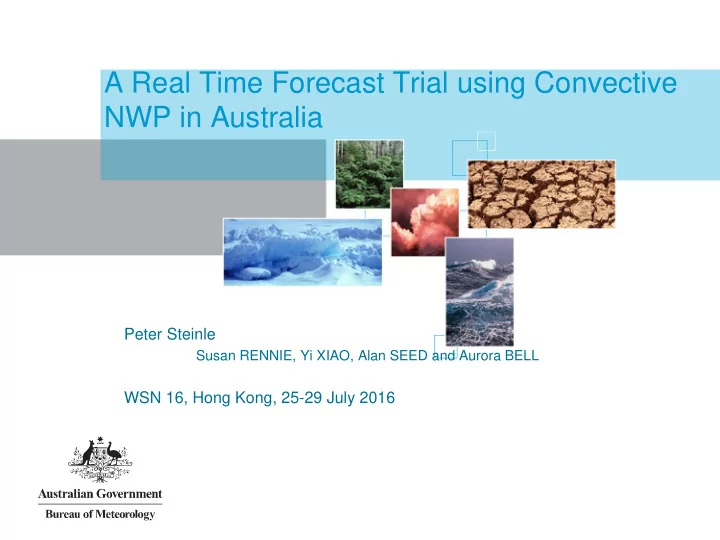

A Real Time Forecast Trial using Convective NWP in Australia Peter Steinle Susan RENNIE, Yi XIAO, Alan SEED and Aurora BELL WSN 16, Hong Kong, 25-29 July 2016 The Centre for Australian Weather and Climate Research A partnership between CSIRO and the Bureau of Meteorology
Forecast Demonstration Project • Major population centre • Significant severe weather (storms, fires etc.) • Reasonable topography • Test 1.5km & Rapid Update Cycle • Use latent heat nudging & Doppler winds • Staggered 2 week forecaster rotation • Detailed recording of forecaster perceptions The Centre for Australian Weather and Climate Research A partnership between CSIRO and the Bureau of Meteorology
ACCESS: APS1 → APS2 70 vertical levels Grid size (km) APS1 APS2 G 40 25 GE - 60 R 12 12 TC 12 12 C 4 1.5 3
NWP system • Based on UKV 2012/2013 • 3dVAR + IAU + Latent Heat Nudging • 1.5km interior, stretched to 4km at boundary • Modified • Latent Heat Nudging (reduced forcing) • Hourly update • Added clear air Doppler winds • Data cutoff at T+55mins (T-30 to T+30mins) • Forecast available ~ T+90 to T+120min The Centre for Australian Weather and Climate Research A partnership between CSIRO and the Bureau of Meteorology
Does the RUC provide improved forecasts? • No end of potential problems: • Initialization/noise, short cut-off, limited obs, QC of single polarized radars….. • …but despite all that • Improved temperature RMSE ~10% • & dew point, but less • Improved rainfall • Windspeed • variance somewhat improved • double penalty problem? • Improvements noticeable in downstream systems • Added value 14-3 out of 50 forecasts ! The Centre for Australian Weather and Climate Research A partnership between CSIRO and the Bureau of Meteorology
Mean of assimilated innovations These have undergone OPS QC and superobbing No major differences between precipitation and insect observations after all QC Bias from undersampling
Observation impact and limitations • Observations at the southerly time of an approaching southerly change Meridional wind speed (m s -1 ) • Most radar Altitude (m) observations are above the height of the change, except near the radar. northerly Latitude
Assimilation in ACCESS-Sydney domain • Modification to model wind field • Observations from multiple radars after assimilation within Sydney domain
Forecaster/User reaction • Importance of full (seamless) integration nowcasting & forecasting • About a week to get used to the system • Had time to discuss and get used to the system • During 2 nd week really start to see the opportunities • Scenario / Interactions of boundaries valuable • Prepared for the event well in advance • Could refine timing once radar/satellite features appear • Lack of responsiveness of DA system • Mid level convection a problem The Centre for Australian Weather and Climate Research A partnership between CSIRO and the Bureau of Meteorology
Conclusions • Much improved wind changes & convective storm lifetime • Mostly courtesy of model • Data assimilation added value • But needs more high resolution detail • Value of DA fades after about 12 hours • Latent Heat nudging marginal value, fades by ~ 6 hours • Need ensemble DA & high res Land DA • Rapid Update very constrained by lateral boundary conditions • Larger scale RUC? • Nowcasting processes need enhancing! The Centre for Australian Weather and Climate Research A partnership between CSIRO and the Bureau of Meteorology
Summary & Thoughts • Showed enough to proceed to develop full operational system • EPS, Hybrid VAR • UM and DA science updates • Phased introduction • 1.5km downscaler RUC Fully integrated nowcast systems • A few days for forecasters to move from current thought processes • Current 6 hour NWP cycle deeply entrenched in processes & systems • By 2 nd week forecasters really get it. The Centre for Australian Weather and Climate Research A partnership between CSIRO and the Bureau of Meteorology
Recommend
More recommend